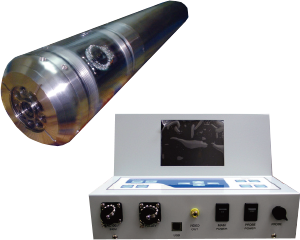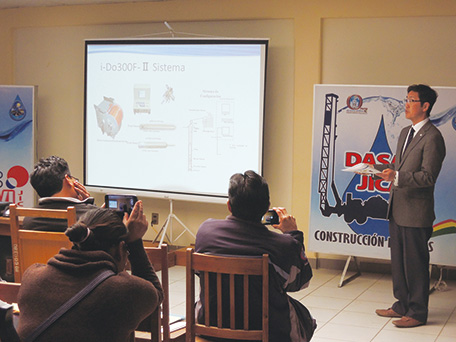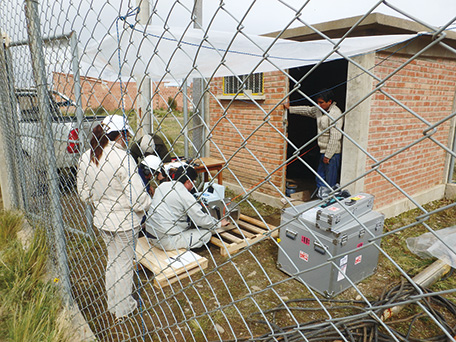Master Techniques, From Japan to the World 1
Extending the Usable Life of Wells in Bolivia
- Using Underwater Cameras for Well Maintenance

A borehole camera system that provides images from inside wells. (Photo: RaaX Co., Ltd.)

A seminar provides explanations on the workflow of repair operations in Santa Cruz Department. (Photo: RaaX Co., Ltd.)
Bolivia is located roughly in the middle of the South American continent and has a wealth of natural resources, including approximately 50% of the world’s lithium. However, infrastructure development needed to support the livelihood of people is still progressing slowly. The situation is particularly serious in rural areas.
Despite declining levels of water, many of Bolivia’s wells have not been sufficiently diagnosed to ensure they are functioning properly. As a result, necessary maintenance and upkeep has not been carried out for restoration of well function. Using a well continuously for many years blocks the screen that prevents impurities in underground water from seeping into the well. This decreases the volume of water that the well supplies and causes poor sanitary conditions.
In Bolivia, however, there has been no method for determining the state of the blockage of screens, which are located deep down in wells. As a result, these blockages have become worse and eventually the underground water has become blocked altogether, resulting in non-functioning wells.
As no technology is available in Bolivia for identifying and locating the cause of the screen blockage, huge sums of money are spent on drilling new wells in other locations, in response to water diminishing. However, drilling a new well is not an easy undertaking because of the large cost involved.
RaaX Co., Ltd. specializes in geological and environmental surveys and is based in Sapporo. The company has developed a product that can solve these problems. RaaX has conducted surveys not only in Hokkaido, but throughout Japan also. The company has developed a borehole camera for checking the condition of fine cracks in the underground bedrock and structure. The company’s borehole camera lineup includes one that is ideally suited for well surveys. The latest model is a camera with multiple focus mechanisms installed on its tip and sides. This makes it possible to record the internal conditions of a well using both video and still images. This camera provides a clear picture of where a blockage is.
RaaX commenced the Feasibility Survey1 for the Project for Well Life Extension Utilizing Effective Well Diagnosis and Rehabilitation Technologies, which uses borehole cameras, in Bolivia in 2014, utilizing ODA under Partnership with Japanese Small and Medium-sized Enterprises (SMEs).2
First, RaaX engineers carried out a demonstration for local experts to show them how the borehole camera worked. The staff of the local public water utility who participated in the demonstration were extremely surprised that the borehole camera could relay clear images of the screen blockage inside the well.
RaaX engineers held the same demonstration twice. They then held technical training sessions in the three cities of La Paz, Oruro and Santa Cruz. During the sessions the engineers used the images and data from open testing to explain the details of the camera’s functions, how to use it, and the general approach for well rehabilitation work.
Through these activities, RaaX’s borehole camera received great acclaim in Bolivia. It was viewed as a revolutionary technology that would make well rehabilitation possible. Soon a local government decided to make use of the camera. A tie-up between RaaX and a local company specializing in well rehabilitation work was then established. This paved the way for the camera’s wider adoption and use.
Mr. Tetsuya Mogami, a RaaX employee in charge of the company’s business in Bolivia, says the following with regard to the Feasibility Survey’s achievements.
“The Feasibility Survey made us keenly aware of the pressing issue of drinking water around the world. In the future, in addition to borehole cameras, we hope to provide the comprehensive know-how needed for local well management, including technology for accurate well diagnosis and cleaning.”
The technologies of an SME from Hokkaido are thus being utilized to improve the lives of people in Bolivia.
*1 A survey on the feasibility of using a certain product or technology for the development of a developing country based on a proposal from a Japanese SME.
*2 Projects aiming to achieve both the development of developing countries and the activation of the Japanese economy by utilizing Japanese SME’s excellent products and technologies through ODA.

A locally-conducted demonstration. (Photo: RaaX Co., Ltd.)
Next Page >>
Main Text | Statistics and Reference Materials | Stories from the field | Master Techniques, From Japan to the World | ODA Topics | A Journalist’s Perspective on Japan’s ODA
